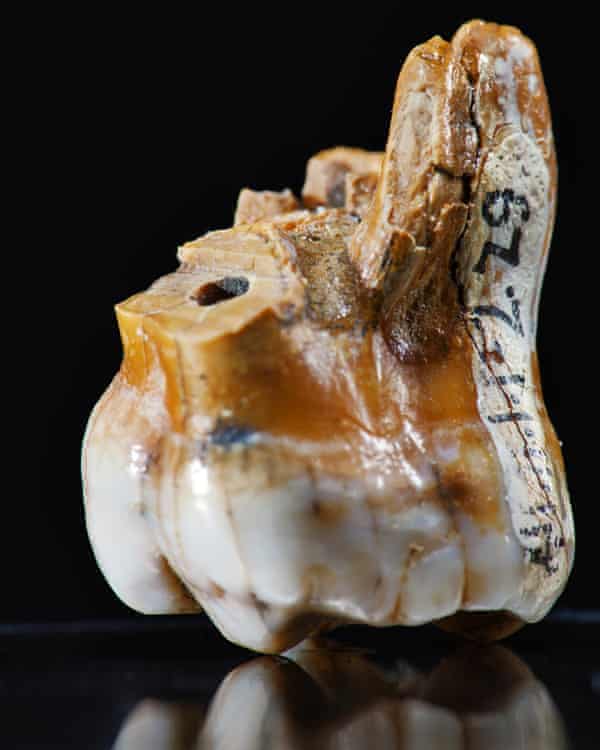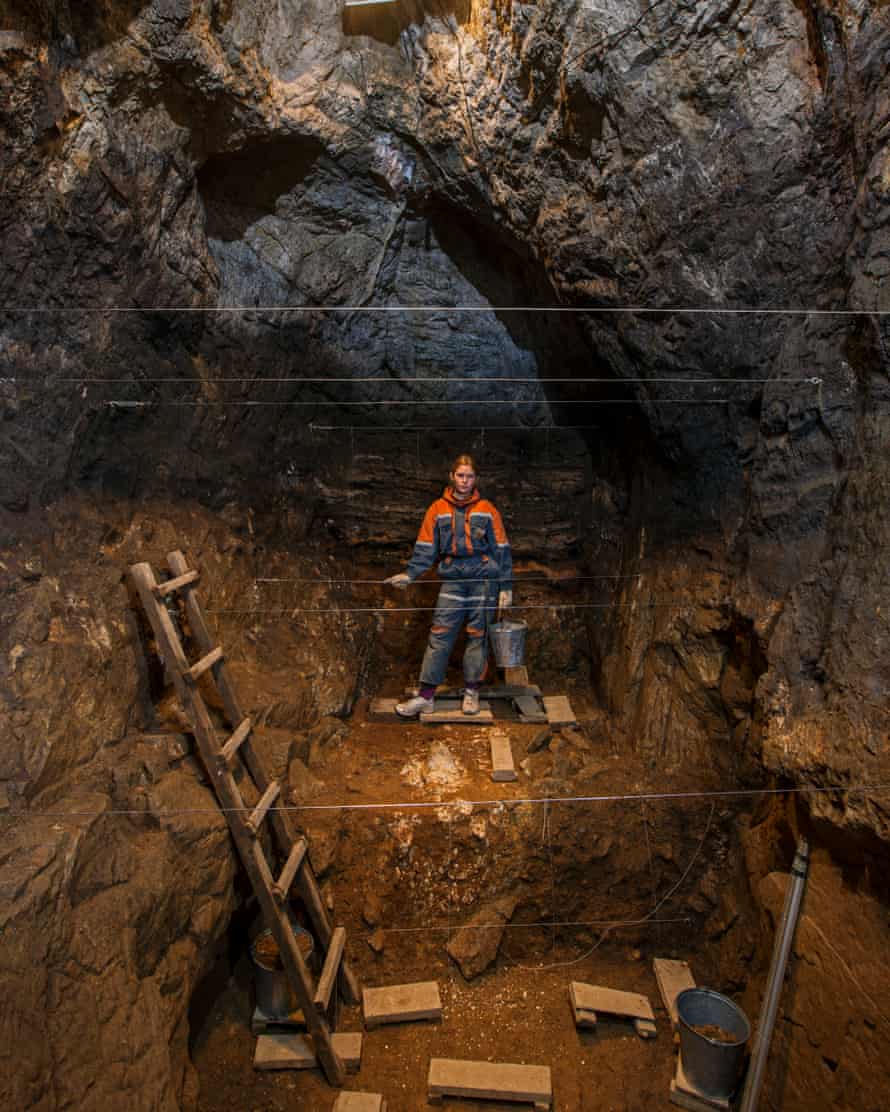Scientists Have Discovered a Girl With the Head of an Adult Woman and a Babies Body
O f all the ancient peoples that have been studied by scientists, none has set puzzles quite and then profound every bit those left behind by the Denisovans. Only a few tiny pieces of bone and teeth have e'er been found of this long extinct species – bitty remains that would all fit snugly inside a cigarette packet.
Yet these fossil scraps advise that Denisovans had a considerable influence on people today. Upward to 6% of the genes now plant in modern New Guineans and 3-5% of the DNA of ancient Australians is made upwards of Denisovan DNA, scientists have discovered. The gene that allows Tibetan people to survive high altitudes is also believed to have been inherited from them. This information tells u.s. one thing: tens of thousands of years agone, modern humans encountered Denisovans – and had sex with them. It is a startling discovery that raises many basic questions. Simply who were the Denisovans? What did they look like? And what were their relations with the Neanderthals, their closest evolutionary cousins? Did they have tools and art like the Neanderthals?
At present, researchers have few answers to these questions, such is the paucity of the Denisovan fossil record. But a new project, Finder – Fossil Fingerprinting and Identification of New Denisovan Remains from Pleistocene Asia – which has been just been launched with backing from the European Inquiry Quango, aims to put that correct and transform our knowledge of the Denisovans and their relations with both Homo sapiens and the Neanderthals. All 3 species interbred, we now know, and a key aim of the report is to help understand these complex bondings: Denisovans will be a special focus, nonetheless.
"We aim to find out where they lived, when they came into contact with mod humans – and why they went extinct," says project leader Katerina Douka, of the Max Planck Institute in Jena, Germany and a visitor at Oxford University.
Denisovan enquiry faces a basic problem, however – paucity of fossils. Denisova Cave in Siberia – where their eponymous remains were first found in 2010 – is our sole source, and only a scattering of fossils have always been dug up there (along with several Neanderthal pieces).
"It is a wonderful site," says Tom Higham, deputy manager of Oxford University's Radiocarbon Accelerator Unit and an adviser to Finder. "Information technology is cool inside, so Deoxyribonucleic acid in basic does non disintegrate too desperately. However, nearly all the bones there have been chewed upward by hyenas and other carnivores." As a consequence, Denisova's cave floor is littered with tiny, unidentifiable os fragments.

"You cannot tell whether a slice comes from a mammoth or a sheep – or a man or woman," adds Higham. "Only a very few will be human, though they are certainly worth finding – they could tell united states so much."
Electric current techniques for identifying bone fragments involve the time-consuming process of extracting and sequencing DNA. "That takes far too long to be applied," says Higham. "At that place are tens of thousands of bits of bones here."
However, Douka and Higham will use a new engineering called Zooarchaeology by mass spectrometry – ZooMs. Adult past Mike Buckley, at Manchester University, the technique, which is derived from food scientific discipline enquiry, exploits the fact that collagen, a protein fibre found in bone, can survive for hundreds of thousands of years. Every major mammal grouping has a distinctive blazon of collagen, and ZooMs can read its structure like a molecular barcode, identifying which brute was the originator of a detail bone. This makes it platonic for differentiating human and animal remains.
"We asked Anatoly Derevyanko and Mikhail Shunkov, who direct the cave's excavations, for samples – and they gave united states of america a big purse total of bits of bones. All the fragments were considered to exist unidentifiable," says Douka.
The team began to prepare the basic. A 20mg piece was cutting from each and placed in a test tube and given an identification code. After iii months, 150 samples had been prepared. "That was nowhere almost plenty," says Higham.
So Douka and Higham asked their postgraduate students for a volunteer to work on the projection. "No one came forward," says Higham. "A calendar week went by, then a fortnight. I was showtime to get worried. So an Australian student, Samantha Brown, knocked on my door and volunteered to work the basic as part of her main'south dissertation. She saved the mean solar day."
Over the next few weeks, Brown undertook the laborious task of cut and labelling tiny slices from each bone fragment. "I somewhen prepared about 700 samples," she recalls. These were so taken to Manchester for analysis in Buckley'southward laboratory. "The results showed we had a lot of cow basic, a few other animals just no humans," says Chocolate-brown. "It was very disappointing."
At that point, Chocolate-brown could have left the project with honour. But she chose to go along. "Thank God she did," says Higham. A further 1,500 Denisova bone samples were prepared past her and then taken to Manchester. This time, the results were spectacularly dissimilar. 1 bone, number ane,227, was identified as being from a human species.
"We could not believe that it had actually worked. Information technology was wonderful," says Douka. Brown was likewise charmed. "It was unbelievably exciting. We had not only shown the technique works but nosotros had found a hominin. And I had been prepared for the worst."

Information technology was tremendous news for the team. But their discovery lacked a key piece of data. Yep, they had found a human of some kind, but which species? ZooMs can tell but if a bone comes from a fellow member of the hominidae family, which includes keen apes and humans, including Man sapiens, Neanderthals and Denisovans. It cannot differentiate within this group. "There have never been great apes around Denisova so that meant we had to have found a piece of a human," says Higham. "But which species?"
To find out, the sample was taken to Svante Pääbo at the Max Planck Institute for Evolutionary Anthropology in Leipzig, whose team had sequenced the first Denisovan genome in 2010. Initial assay showed that the bone was more than than fifty,000 years old and from a person who had been 13 or older when they died.
Then the Leipzig team – led by Pääbo's pupil Viviane Slon – began more detailed genetic analysis and fabricated a startling discovery. Exactly half the sample consisted of Neanderthal Dna. The other half was made upward of Denisovan DNA. At first, the researchers assumed that the sample was contaminated. "I thought they must have screwed up something," says Pääbo.
But re-testing confirmed the finding: the Oxford team had discovered the xc,000-yr-old remains of a hybrid girl of a Neanderthal mother and a Denisovan male parent. She was nicknamed Denny. "If you had asked me beforehand, I would have said we volition never find this, it is like finding a needle in a haystack," Pääbo told Nature.
To discover a first-generation person of mixed beginnings was boggling. Simply there were more revelations to come. Further detailed studies of the genes of Denny'south Denisovan father were found to comprise fragments of Neanderthal DNA. These indicated that interbreeding between the ii species had likewise occurred at an earlier time.
At first sight, Denny'south remarkable ancestry suggests that Neanderthals and Denisovans must have mated with each other regularly. But Douka counsels circumspection. "The Dna of Neanderthals and Denisovans are singled-out. We tin easily tell them apart. That argues against frequent interbreeding. Otherwise they would have ended up with the same DNA."
Past studies have provided articulate evidence that Denisovans and modernistic humans interbred, and also that Neanderthals and mod humans mated with each. At present, cheers to ZooMs – which has since been used to pinpoint other ancient human being remains – at that place is dramatic evidence of Denisovan and Neanderthal intermingling. But why at Denisova?
1 suggestion is that the cavern represents a border outpost for both species, 1 that was situated at the very eastern edge of the range of the Neanderthals, who were primarily a European species, and at the very western tip of the homelands of the Denisovans, who were an eastern species. Occasionally members from both groups would take reached the cave at the same time – with amorous consequences.
It is an idea borne out past detailed studies of Denny's Neanderthal mother. Her genes show a specially close affinity with Neanderthals who lived in Republic of croatia, suggesting that the immediate predecessors of Denny's mother may have been part of a grouping who slowly migrated e from Europe towards Denisova – where she encountered Denny's father at the outer edges of each other's homelands.

It is an intriguing picture, though much more than information is required to confirm it. Scientists have no straight evidence that the Denisovans' homeland range was primarily to the e of the cave, although the fact that their genes have been detected in the DNA of populations in Australia, New Guinea and other parts of Oceania, provides support for this idea and suggests future searches for sites should be focused on eastern Russia, China and south-east asia.
A neat deal more than needs to exist learned nearly the Denisovans, says Higham: "What was their distribution? What is the earliest prove for their emergence from the mutual ancestor they shared with Neanderthals 500,000 years ago? If we could get a bone or two from other sites, that would be tremendously helpful." 1 possible source of fossils could include remains of ancient humans that were placed in museums in Asia decades ago. These could be wrongly labelled, and could be Denisovans, researchers suggest. Unfortunately, it has proved hard to get hold of these specimens for sampling.
For their part, Douka and Higham are planning on a number of approaches. One of these will be to collaborate with researchers in Chinese laboratories, teaching them how to use ZooMs, and how to use the engineering to uncover more Denisovan sites.
"ZooMs is going to be crucial to this projection," says Douka. "We have shown that information technology is a powerful tool for pinpointing human fossils. That makes information technology platonic for tracking down Denisovans."
The riches inside Denisovan DNA
Knowledge of the Denisovan people emerged from studies of ancient genomes, which began twenty years ago when scientists commencement adult techniques for extracting Deoxyribonucleic acid from fossils and for creating copies of that genetic material which allowed them to written report it.
Scientists at the Max Planck Found in Leipzig were studying bones and teeth found in Denisova cave in the Altai Mountains in Siberia, where Neanderthal fossils had been found. One bone and i tooth, they discovered, belonged to a previously unknown species of aboriginal human.
These few fossils proved to be spectacularly rich in genetic textile, allowing scientists to sequence entire genomes. It is this detailed data about the Denisovan genome that has demonstrated they interbred with modern humans.
Descendants of these unions, conveying small amounts of Denisovan DNA, went on to settle in Melanesia and Commonwealth of australia thousands of years ago.
In this fashion, we tin run into Denisovan Dna in that of modern humans, though we take no idea what the Denisovans looked like or where, exactly, they lived.
Source: https://www.theguardian.com/science/2018/nov/24/denisovan-neanderthal-hybrid-denny-dna-finder-project
0 Response to "Scientists Have Discovered a Girl With the Head of an Adult Woman and a Babies Body"
Post a Comment